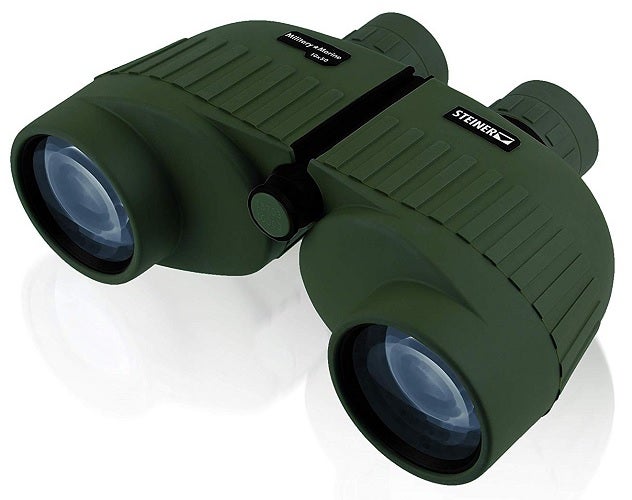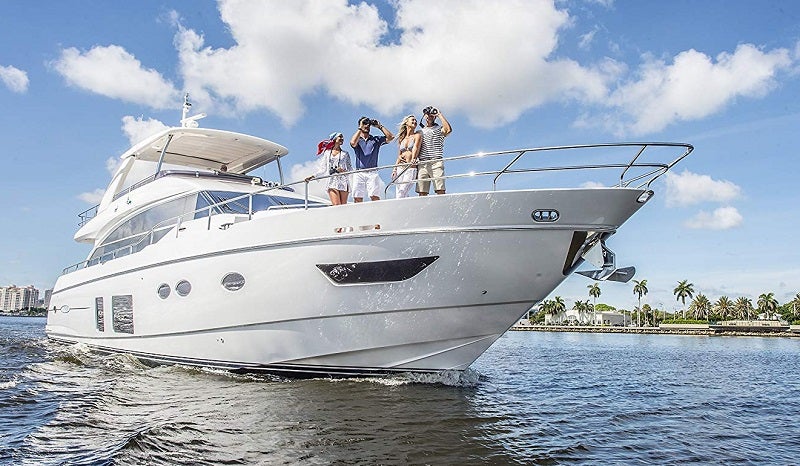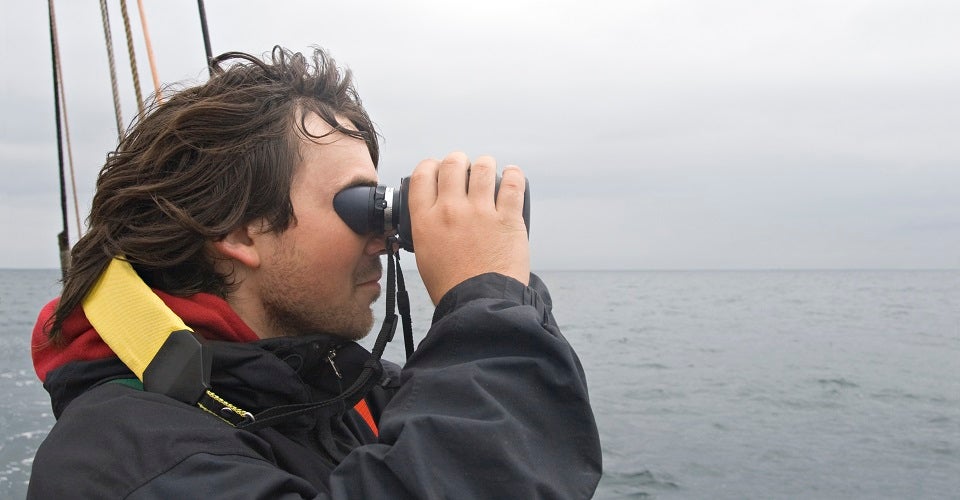
Our Editors independently research, test, and rate what we feel are the best products. We use affiliate links and may receive a small commission on purchases.
When it’s time to head out on the water, the last thing you want to do is go sailing blind.
For those who boat on all but the smallest water bodies binoculars add a versatile utility tool to your vessel that just can’t be left at home. What kind of binoculars are good for marine use, though?
To help you, I’m going to recommend a few of the top marine binoculars so you can spend more time on the water and less time shopping!
Best Marine Binoculars
For more of my marine recommendations, have a look through these popular Outside Pursuits guide links: Marine VHF Radio, Marine Batteries, Marine GPS/Chartplotter.
Quick Answer: The 7 Best Rated Marine Binoculars For 2021
- Steiner Military-Marine Binoculars
- Nikon OceanPro Global Compass
- Canon Image Stabilization Waterproof Binoculars
- Bushnell H2O Waterproof/Fogproof Binocular
- Steiner Marine Commander Series Binoculars
- Aomekie Marine Binoculars
- Bushnell H2O Waterproof/Fogproof Binocular
Our reviews of the top rated marine binoculars with a comparison table and buyers guide will help you choose the right pair for you.
Marine Binocular Reviews
#1 Steiner Military-Marine Binoculars
- Optics: 10×50
- FOV@1000yds: 302 ft
- Weight: 36oz
- Type: Analog
- Waterproof: Yes
Steiner makes one of the most popular variants of the classic marine binocular styles out there today. They may not be feature-loaded but they do focus heavily on reliability in harsh conditions.
These are the classic 10×50 combo. A perfect blend of image clarity and zoom power for marine use that has been common for decades.
Steiner used a polycarbonate chassis to keep weight down and wrapped the whole thing in a drab green rubber coating for grip and waterproofness. It practically oozes “military”. At the same time, however, it’s a simple and effective design.
One thing I think anyone will like about these binoculars is that after setup all images from 20 yards to infinity show up in perfect clarity without having to fiddle with adjustments.
The Steiner Military-Marine’s are the best marine binoculars that are reliable and proven!
#2 Nikon OceanPro 7×50 Global Compass
- Optics: 7×50
- FOV@1000yds: 380 ft
- Weight: 40oz
- Type: Digital
- Waterproof: Yes
Another classic take on the standard marine compass but this time Nikon takes things up a notch. They got more ambitious with these and they’ll definitely appeal to the tech-gurus out there.
Nikon is, of course, one of the big names in optics and they didn’t miss with these. Everything you’d expect is in here such as the Porro prism, coated lenses, and waterproof housing for marine use.
What might surprise you is that these binoculars include a heads up style compass bearing indicator inside the eyepiece. This overlay is illuminated and features size estimators for objects in the distance.
It’s worth noting that the field of view on these optics is about 7 degrees which equate to 380 feet at 1,000 yards.
Best for navigational aids when confirming or calculating a bearing at a distance.
#3 Canon 10×42 Image Stabilization Waterproof Binoculars
- Optics: 7×50
- FOV@1000yds: N/A
- Weight: 39oz
- Type: Digital
- Waterproof: Yes
Canon, with their experience bringing together tech and optics, has delivered a marine powerhouse to the table. If you’re technologically impaired, however, steer clear!
Something we haven’t talked about yet is image stabilization. Using electronics and sensors these binoculars actually offset any minor movement and help smooth out vibrations when viewing.
For marine applications, this might become immediately apparent why it’s helpful. High zoom (such as 10x+) and waves just don’t go well together. So, with digital image stabilization, you can get that high zoom and still be able to see!
These optics are simple with just a single button to operate, two AA batteries, and two focus adjustments. Anyone can learn to use them, but there are drawbacks.
If you run out of batteries you’ll be left with an almost unusable binocular set.
The Canon’s are the best boating binoculars for extreme distance viewing and for those with very deep pockets (they’re expensive!).
#4 Bushnell H2O Waterproof/Fogproof Roof Prism Binocular
- Optics: 8×42
- FOV@1000yds: 305ft
- Weight: 25 oz
- Type: Analog
- Waterproof: Yes
Compact and affordable is the name of the game here. These Bushnell binoculars might not be top of the line but they also won’t break your budget either!
You’re probably the right person for these binoculars if you want high mobility, small form factor, and low cost. Overall they’re a good balance of budget and value but they may lack some features picky users seek.
With the roof prism design, they’re quite small and can easily fit in a pocket or backpack. However, the smaller 42mm objectives may lack clarity of image in low light conditions and some might consider the 8x zoom too high for marine use.
That said, though, at the very affordable price compared to many high-end marine binoculars these rather minor drawbacks may be trivial to some users who will find these binoculars just fine!
Best for low budgets and lightweight, compact form factor.
#5 Steiner Marine Commander Series Binoculars
- Optics: 7×50
- FOV@1000yds: N/A
- Weight: 42oz
- Type: Analog or Digital
- Waterproof: Yes
Loaded with top features and ready for almost any marine application, these binoculars would make Captain Hook proud. There’s hardly an end to the features packed into these optics.
Let me clear something up right out of the gate. These binoculars are available both with and without the digital compass overlay.
If you’ve got deep pockets and don’t mind paying for the feature, the compass is a great navigational tool. On the other hand, you can save a few benjamins by going with the purely analog (but still pricey) model.
Wrap around eyecups, auto-focus from 20 yards to infinity, and waterproof up to 33ft means you can really put these binoculars through the paces out there. Steiner also stands behind these binoculars with a lifetime warranty (doesn’t cover damage or theft).
Best for those seeking absolute top end quality and features with deep pockets.
#6 Aomekie Marine Binoculars
- Optics: 7×50
- FOV@1000yds: 390ft
- Weight: 34oz
- Type: Digital
- Waterproof: Yes
Maybe not a major name brand, but loaded with major features. You’ll save a few bucks by considering these binoculars as your marine companion this year.
At the budget price, you might be wondering about quality, but it seems to be there. Users love these binoculars and they’re loaded up with features.
Coated lenses improve optical clarity, nitrogen-filled bodies prevent internal fogging, and IPX7 waterproof rating means they’re good at 1 meter for up to 30 minutes of submersion.
Maybe the most surprising feature of these affordable binoculars, however, is the compass and rangefinder. These are analog tools overlaid on the image (like a rifle scope) that can be adjusted with an external ring.
Once adjusted these gradient markings show you which direction and how far your target is. You can also use the built-in light to help you see the compass and rangefinder markings in low light conditions.
Best for tight budgets and advanced features packed into a very affordable pair of binoculars.
#7 Bushnell H2O Waterproof/Fogproof Porro Prism Binocular
- Optics: 7×50
- FOV@1000yds: N/A
- Weight: 35oz
- Type: Analog
- Waterproof: Yes
Last time we looked at a Bushnell binocular it was a compact model. This time we’re bringing out the big guns and taking the game up a notch for those who don’t mind large optics.
These optics are one of the most affordable options on our list and yet, somehow, they pack in all of the classic features.
You really can’t go wrong with the 7×50 form factor. Rubber eyecups provide some adjustment for glasses users. A single focus knob keeps things simple and a diopter adjustment allows for fine-tuning.
One of the best features on these optics is the ultra-gripper textured rubber housing. Plus, for you old-fashioned types, these are totally analog so there are no batteries or digital overlays to go wrong.
Nitrogen purged and 100% waterproof, these optics won’t break the bank but they will get you ready to navigate the open water!
Best for a reliable pair of marine binoculars from a trusted name at a very reasonable price.
Marine Binoculars Comparison Table
| Marine Binoculars | Optics | FOV@1000yds | Weight | Rating | |
|---|---|---|---|---|---|
| Steiner Military-Marine Binoculars | 10x50 | 302 ft | 36oz | 5.0 / 5.0 | |
| Nikon OceanPro 7x50 Global Compass | 7x50 | 380 ft | 40oz | 4.8 / 5.0 | |
| Canon Image Stabilization Binoculars | 7x50 | N/A | 39oz | 4.2 / 5.0 | |
| Bushnell H2O Waterproof/Fogproof Binocular | 8x42 | 305ft | 25 oz | 4.6 / 5.0 | |
| Steiner Marine Commander Binoculars | 7x50 | N/A | 42oz | 5.0 / 5.0 | |
| Aomekie Marine Binoculars | 7x50 | 390ft | 34oz | 4.4 / 5.0 | |
| Bushnell H2O Waterproof/Fogproof Binocular | 7x50 | N/A | 35oz | 4.4 / 5.0 |
How to Choose the Best Marine Binoculars for You
Magnification
It goes without saying that the primary goal of any binocular is to magnify an image. How much magnification, however, is a bit hard to pin down.
You might be tempted, like many, to think that more zoom is better than less. That might be true, but it comes with some drawbacks at the same time.
In marine situations when you’re moving and your target is moving, more zoom means more vibration and movement. Any movement of the vessel (and most vessels move quite a lot) will be amplified by your binoculars. Choose optics with too much zoom and you may be struggling to see anything at all!
Most will recommend zoom from 6-8x for marine applications – anything greater will require optical stabilization which can be very pricey and is only available on extremely high-end optics.
Objective Lens Size
On any binocular, the objective lens is the lens that is closest to the object you’re viewing. No, that’s not why it’s called “objective” but it’s an easy way to remember.
Essentially, bigger objective lenses allow for better images when viewing through the binocular. It’s really that simple.
Of course, there’s more to it if you want to understand all the details. One major factor that bigger objective lenses contribute to is light gathering. Larger lenses are capable of gathering up more light which leads to better and crisper images in poor conditions or low light.
For marine applications, the standard recommended size is about a 50mm. Slightly smaller might be a good choice for portability. Meanwhile larger objectives sizes (while harder to find and more expensive) are better for those who regularly use their optics in low or poor light.
How to Read Binocular Size
Most binoculars are rated with a standard scale system. Once you learn how it works, there’s really nothing to it.
You’ll see a number like this: 7×50.
That number represents two things. First (7) is the magnification power of the optics. Second (50) is the size of the objective lens in millimeters.
It’s that simple!
Prism Type
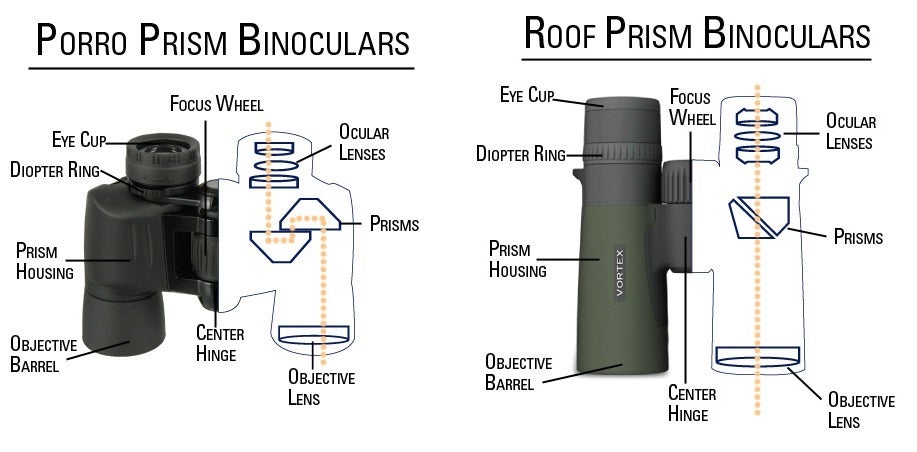
In binoculars, a prism’s job is to flip an image right-side-up. Because of the nature of light, the light that would reach your eye without a prism in your binoculars would cause you to see things upside down. Thus the importance of a prism inside binoculars.
In marine binoculars there are essentially two types of prisms you’ll encounter.
Roof prisms – allow binoculars to be made in a relatively small and compact form factor. This is great for confined spaces, compact carrying, and portability.
Porro prisms – on the other hand, feature improved depth of field and field of view (which we’ll talk about shortly). That comes at the cost of binoculars that are relatively larger than those with roof prisms.
Basically, if your priority is compactness and portability go with a roof prism style. If your goal is image quality, then a Porro is probably better for you!
Depth of Field
Depth of field refers to the span of distance away from you in which objects are in focus. Let me try to explain.
If you focus on your binoculars on an object 100ft away you may find that something 80ft away and something 120ft away are both in focus. However, objects closer than 80ft and further than 120ft may not be in focus. This is an example of the depth of field.
Depth of field can be affected by several factors but most of them are inherent to your binoculars. Prism type, size, and shape of lenses, apertures, and other technical factors all predetermine the depth of field you’ll get.
On most binoculars, you’ll find that past a certain range all objects are in focus.
Field of View (FOV)
This term refers to how wide of space is visible at a certain distance when looking through your binoculars. Usually, it’s measured at 1,000 yards out and represented in degrees. Additionally, each degree is equal to about 50 feet of view angle.
For instance binoculars with a 7-degree field of view would show you 350 feet of the horizon at a distance of 1,000 yards.
Wide field of view is great for pulling up and quickly locating objects or viewing moving objects. It gives you more wiggle room in acquiring the image you’re seeking.
Wider field of view binoculars also come with some drawbacks, however. The wider the field of view, generally, the poorer the image quality tends to be (though this can be offset in extremely high-end optics).
Types Glass Used in Lenses
BK7 Glass – This is low end glass used to make prisms and found only on cheap binoculars. It suffers from chromatic aberration resulting in blurry images even when in focus.
BAK-4 Glass – A very common glass used in quality optics for binoculars. It has a low refractive index and resistance to chemical and environmental damage.
ED Glass – Extra-Low Dispersion is widely used in optics in high end binoculars to provide clarity and crisp views. This is especially important at higher magnifications to reduce chromatic aberration.
Schott ED Glass – This is a proprietary glass created by Schott Optics that has the lowest chromatic aberration of any glass and found very high end binoculars.
Eye Relief
This refers to the distance between the eyepiece and your eye. Eye relief primarily comes into play when you’re wearing glasses, goggles, or other headwear.
To get around changes in eye relief (due to putting on or taking off glasses) you’ll want to check for binoculars with rubber eyecups. These eye cups can be opened up or folded down to accommodate for the use of (or lack of) glasses.
If you’ve got deeper pockets you can consider binoculars with adjustable viewing thanks to diopters which can alleviate the need for eyeglasses.
Waterproofing and Armor
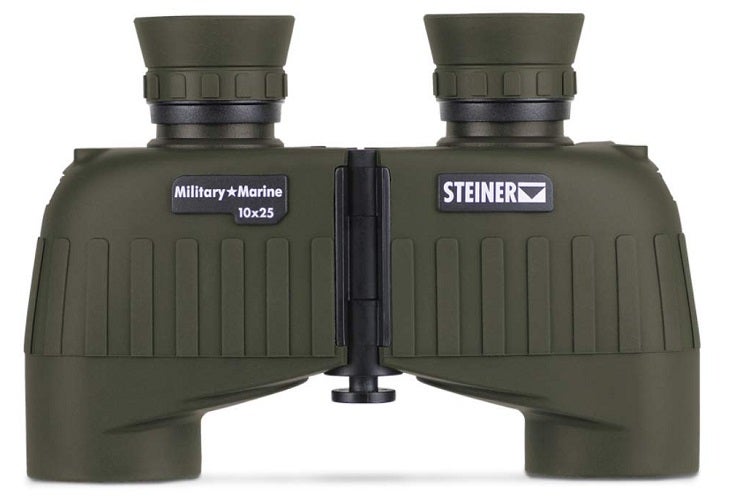
Nope, not medieval armor. We’re talking about armored protective bodies for your binoculars.
You may find these in many different forms but some of the most common are:
- Rubber coatings
- Waterproof housings
- Drop resistance
- Shock resistance
- Temperature resistance
- Fogproofness
I think it almost goes without saying that in the world of marine optics you really need waterproof and fog proof binoculars. Whether you want rubber coated optics or armored optics is really up to you so long as you start with waterproof and fog proof models.
Fogproof Inert Gas
Most high-end binoculars will be fogproof. How do binocular manufacturers do this? There are two methods:
One, they may apply fog resistant coatings to lens exteriors or interiors. This is an inexpensive way for them to create fog resistant binocular lenses.
Second, and pricier, is the inert gas option. Some manufacturers will fill the inside of the binocular with a special gas.
Instead of atmospheric gas which may contain moisture, binocular makers can choose to fill the binocular with inert gas usually nitrogen, then seal the binocular to outside air. This means the binoculars can’t fog up unless air leaks in.
Heads Up Display
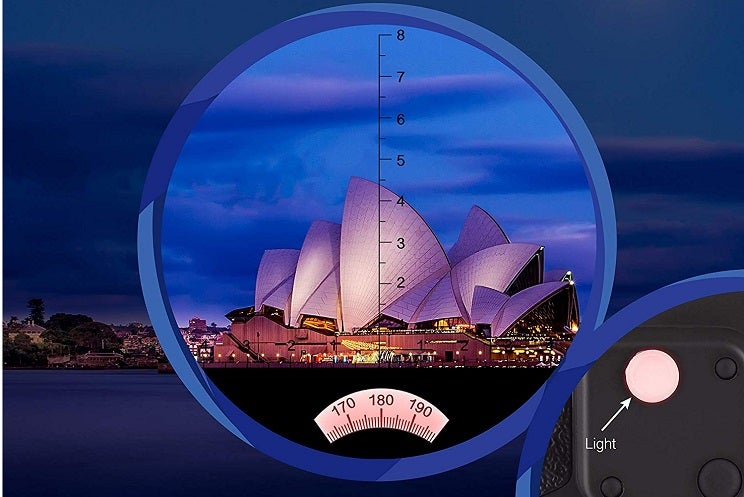
Maybe not technically a HUD, but there are features for some high-end binoculars that integrate some augmented reality.
If you’re looking for some of the most powerful navigation and orienteering aids out there here are a couple of things to check out.
Look for integrated compasses in your binoculars. These are usually digital bearings and compass overlays that show in realtime as you look through your binoculars. They can be tuned for a specific region or calibrated to work anywhere in the world!
Another cool feature to look for is a rangefinder. Again, these usually show up as an on-screen overlay when looking through the binoculars. When combined with a compass you can see which direction and how far away the object you’re observing is!
Expect to pay big bucks for either or both of these features.
Remember that any time you have digital features the chances for things to go wrong increases. You’ll need batteries (or a way to recharge) these digital devices. On top of that, some just don’t work at all when out of batteries. Bummer!
FAQs About Marine Binoculars
Q: What are lens coatings?
A: Coated lenses help cut down on reflection and scattering which leads to a clearer image. By nature, when light hits the glass, some of the light is reflected and some passes through in random paths. The goal of lens coatings is to reduce these unwanted occurrences.
Coated lenses cut down on light lost due to these unwanted phenomena and can make a measurable improvement in final image quality and brightness.
Q: What does it mean to be “fully multi-coated”?
A: Multi-coated lenses have more than one coating of image-improving technology on their lenses for an overall performance increase.
Fully multi-coated lenses have several coats of image-enhancing tech applied to every single surface that makes contact with the light passing through. Remember, inside each binocular there are many surfaces that light bounces off of or passes through before it reaches your eyes.
Fully multi-coated implies that the manufacturer has gone to the greatest possible lengths to apply coatings to every important surface.
Q: Does exit pupil diameter really matter?
A: In low light conditions, particularly, yes it does.
Exit pupil diameter is the size of the image exiting the binocular eyepiece and making contact with your eyes. This is a factor of both the magnification power of your binoculars and their objective lens size.
The darker it is outside, the more important exit pupil diameter becomes since the bigger the image leaving the binocular, the better your eyes can pick it up and see every detail. This is one reason why it’s desirable to have large objective lenses and lower zoom powers in dark conditions.
Q: How should I clean my binoculars?
A: People will have various recommendations here, but I’ll share my thoughts.
First, if the manufacturer supplied you with a cleaning tool or cleaning instructions then defer to them!
Further, it’s very important to use a cloth or tool specifically made for cleaning lenses. On top of that, you have to be certain that it is clean and free of debris.
Unknown cloths, tools, or fabrics may be abrasive or contain invisible abrasive elements that could rapidly damage your expensive optics. Do yourself a favor and invest some money into a cleaning tool that you can use for peace of mind.
I strongly recommend against cleaning lenses with your shirt, sleeves, jacket or the nearest towel in reach.
Q: What is a variable zoom binocular?
A: If you run into something like 7-10×50 when searching for binoculars you’ve found variable zoom binocs!
Just like reading the binocular numbers we talked about earlier, the magnification comes first. In the example above the minimum magnification would be 7x all the way up to 10x. Of course, the objective lens size, in this example, would be 50mm no matter what magnification you use.
Variable zoom optics come with drawbacks and most hardcore users will tell you that they’re never as good as a fixed magnification version. I’m inclined to agree though I doubt most occasional users will notice the difference.
If you want the absolute best image quality available, avoid variable zoom marine binoculars.
Outside Pursuits Overview
When it comes time to hit the high seas in search of booty you’ll need to be able to see those land-lubbers coming. All jokes aside, we hope you’ve learned a bit about marine binoculars and what to look for.
Be sure to check out our list of this year’s best readily-available boating binoculars and get a head start on your research. Double check the “how to choose” section if you have any questions and you’ll spend less time shopping and more time on the water!
How We Researched
To come up with the top marine binoculars we researched a variety of sources for reviews such as REI, Dicks Sporting Goods, Cabelas and Backcountry along with our own personal experience.
We also consulted online magazines for product research and reviews to get as much unbiased information as we could. To help weed out fake reviews we used Fakespot.com to make sure we only looked at genuine reviews.
With so much quality gear available, we had to narrow it down based on what we felt were the best options for the price. The author, Casey Fiedler has been an avid boater for over 10 years.
To help narrow down the selection he used his personal experience along with recommendations from boat captains and fellow boaters.
After extensive research, we came up with our list to help you choose the right one for you.

